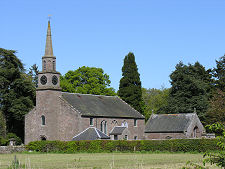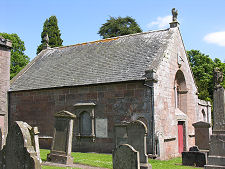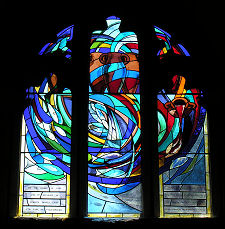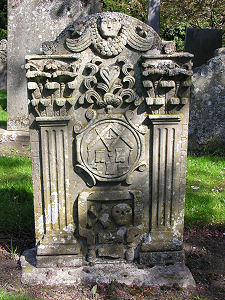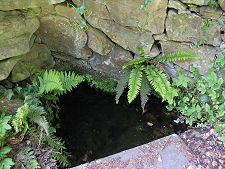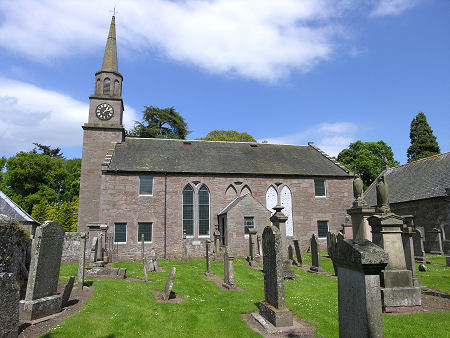 St Fergus Kirk from the South |
St Fergus Church stands at the end of Kirk Wynd in the village of Glamis, close to one of the gateways into the grounds of Glamis Castle. The church you see today was completed in 1792 as a replacement for the first stone church to be built on this site, which was consecrated in 1242.
One part of the older church remains. Immediately to the south of the main church is the Strathmore Aisle. This was built some time between 1459 and 1484 by Isabella Ogilvy, in memory of her husband, Patrick Lyon, the 1st Lord Glamis. The aisle seems to have been built as a south transept to the medieval church and when the rest of that church was pulled down to make room for its successor, the aisle became a free standing building.
Today the surrounding kirkyard is home to a range of old Scottish gravestones, some of which are highly decorated. Some carry the traditional emblems of trades such as masons, weavers and brewers. Also here is the grave of Margaret Bridie, the inventor of the "Forfar Bridie", a type of meat pastry which she made in Glamis and sold at the market in Forfar. The oldest gravestone in the kirkyard is dated 1607.
The interior of the church you see today dates back largely to a major remodelling which took place in 1933. Until then, St Fergus Kirk had been a typical post-Reformation "preaching box", with a pulpit positioned mid way along the south wall; the ground floor pews aligned to face it; and galleries on the north side and at the east and west ends of the church.
In 1933 a new chancel was built at the east end, connected to the nave by a beautifully proportioned arch. All the pews were re-oriented to face the east end, which is where the communion table and pulpit have since stood. The north and east galleries were removed: today only the west gallery remains. Most of the nicely carved woodwork within the church was the work of the congregation, and even the carpet, now hanging on the north wall, was made by the ladies of the church. The wooden cross which stands in the chancel carries a design copied from the cross on the Glamis Manse Symbol Stone, a Pictish cross slab which stands in the garden of the nearby manse.
When the new church was built in 1792 the Strathmore Aisle was left as a separate structure. This stood derelict for a period until it was renovated in 1971 and reconnected to the church. The Strathmore Aisle is very evidently much older than the rest of the church and comes complete with a vaulted ceiling and a range of detailed features and carvings. One of the highlights of the aisle is the raised tomb in which lie the remains of both Patrick Lyon and Isabella Ogilvy. Less obvious is that beneath the floor of the aisle is a burial vault in which successive generations of the House of Strathmore, the residents of Glamis Castle, have been buried.
A more recent addition to the Strathmore aisle is the superb stained glass window in the south wall. This was installed in 2001 in memory of Fergus, 17th Earl of Strathmore, and though carrying themes inspired by the Bible is strikingly modern in style. The artist was Mrs Emma Butler-Cole Aiken. The nave of the main church has also benefitted from the installation of stained glass windows in both north and south walls since the 1933 renovation.
Although the first stone church on this site dated back to the 1200s, the story of Christianity in Glamis has much earlier origins. It is believe that St Fergus founded a church close to the site of today's St Fergus Kirk in the 600s, after training in Ireland. This first church would have been built of wattle and mud, and no trace of it, or the wooden churches that might have followed, have ever been found.
St Fergus is remembered in various parts of Scotland. There is a village (and a gas terminal) named after him north of Peterhead, and he is the patron saint of Wick. At Glamis, he is remembered in the name of the church. Close to the church is St Fergus Well, a spring which emerged beside the Glamis Burn said to have been used by St Fergus for baptisms. You reach this from the church by walking through the gates to the Glamis Estate near the church, then turning right and descending steps to the side of the burn. St Fergus is said to have been buried at Glamis, though no trace has been found of his or of other Pictish burials thought to have taken place here.
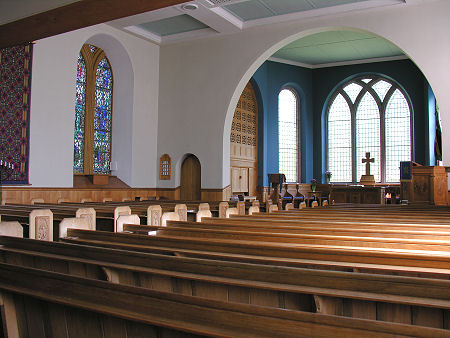 The Interior, Looking South-East |

|
|
|
Visitor InformationView Location on MapGrid Ref: NO 352 474 Church web page What3Words Location: ///aimed.landings.retract |
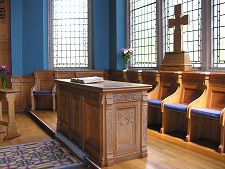 Communion Table and Cross |
 Tomb of the 1st Lord & Lady Glamis |
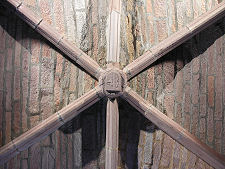 Vaulting in the Strathmore Aisle |
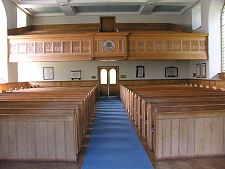 Looking West Inside the Kirk |
 Crest on the Gallery |
